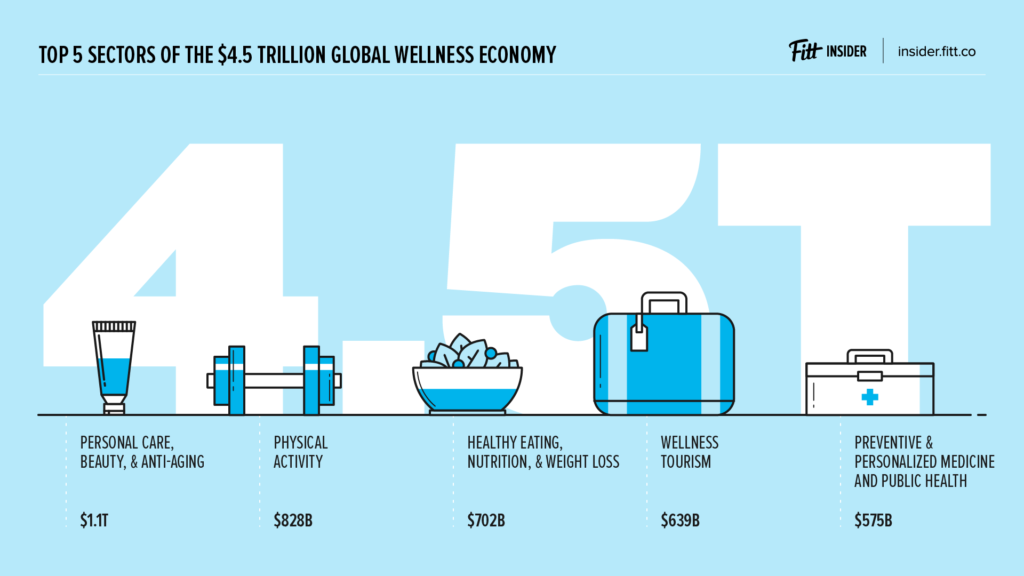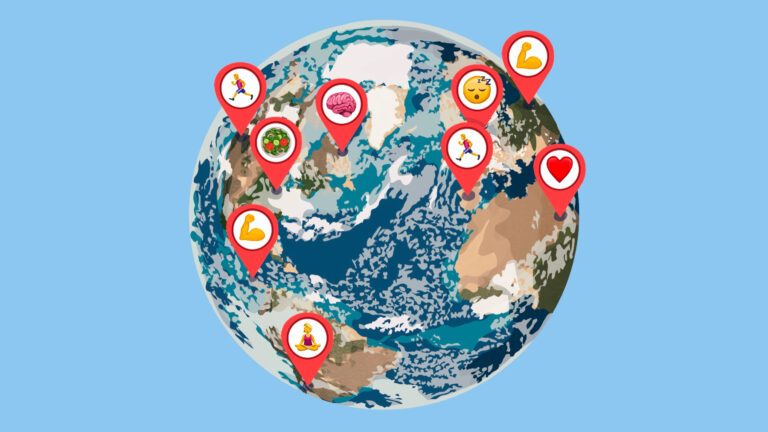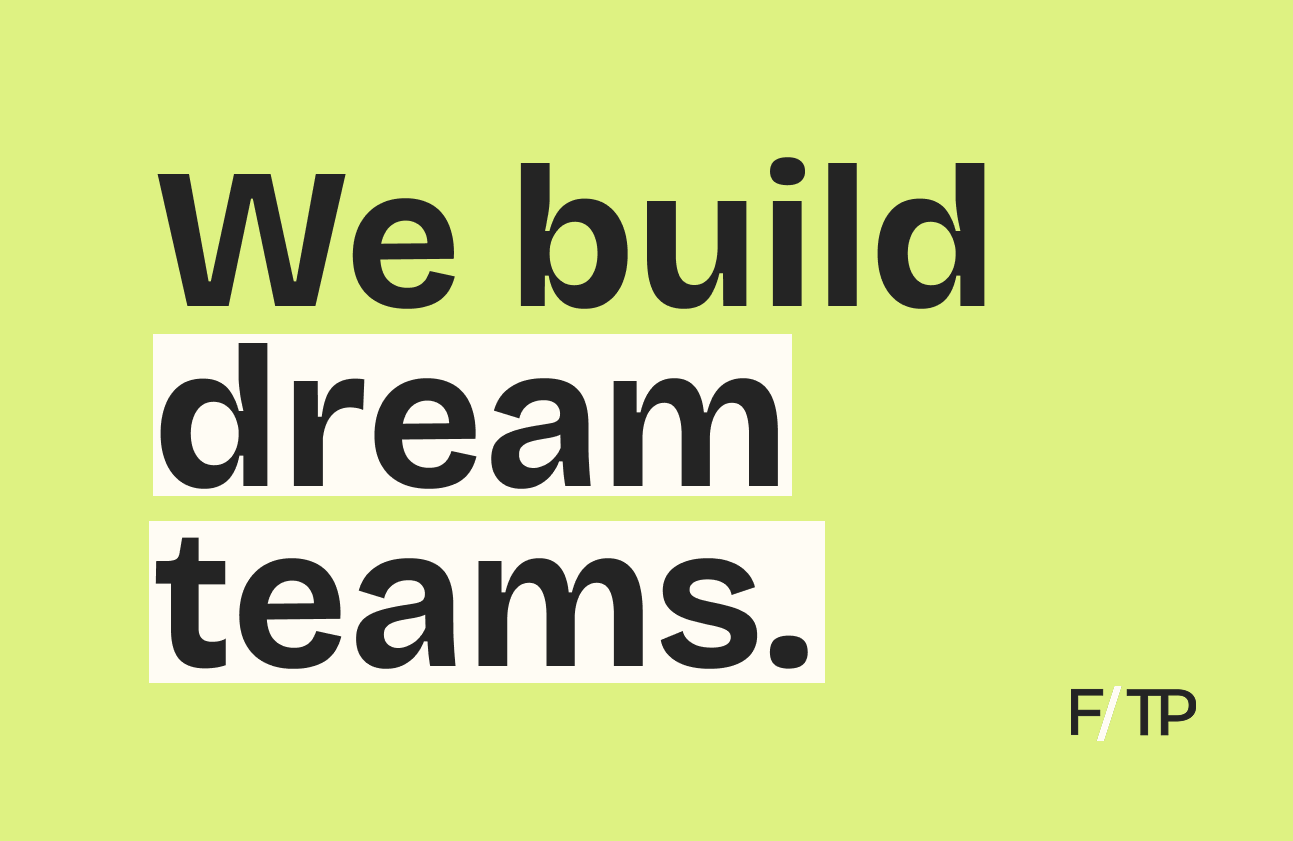Peak Wellness
Last week, new research from the Global Wellness Institute (GWI) valued the worldwide wellness industry at a record high of $4.5 trillion-with-a-“T”. From physical activity to anti-aging and personalized medicine to tourism, the report makes it clear: wellness is infiltrating every aspect of our lives. But what exactly does that mean and is it actually a good thing? Let’s take a look.
According to the GWI report, the top five sectors of the expansive wellness industry include:
- Personal Care, Beauty, & Anti-Aging: $1.1T
- Physical Activity: $828B
- Healthy Eating, Nutrition, & Weight Loss: $702B
- Wellness Tourism: $639B
- Preventive & Personalized Medicine and Public Health: $575B
A Closer Look
The “physical activity economy” was identified as being a driving force behind the industry’s growth. In all, this sector of the wellness industry accounts for consumer spending on sports and recreation ($230B), fitness ($109B), mindful movement ($29B), equipment and supplies ($109B), apparel and footwear ($333B), and technology ($26B).
By 2023, the physical activity sector is expected to exceed $1.1T in value, further contributing to the proliferation of wellness. Of note, during that same period, the Asia-Pacific region is expected to overtake North America as the largest region by expenditures.
The good. For operators and brands in the space, wellness has proven to be a gold mine. The altruistic hope is that the world becomes a healthier, happier place thanks to flourishing wellness brands, connected fitness equipment, and meditation studios on every corner.
The bad. We’re spending more on wellness than ever before, but (in the US, anyway) we’re increasingly unwell. From obesity to diabetes and burnout to depression, the word “wellness” is well-intentioned, but it’s certainly not an antidote. Worse, long-term, overuse (and misuse) of “wellness” runs the risk of becoming devoid of meaning.
Zooming out. Whether it’s the pursuit of physical fitness, longevity, or vanity, a number of factors have contributed to the rise of “wellness”. But over time, the Wellness Industrial Complex turned the rewarding journey toward well-being into a status-signaling luxury good. As a result, wellness is poised for an unbundling of sorts.
The Unbundling of Wellness
When every brand is a wellness brand, being a wellness brand doesn’t mean anything. As a result, we’ll see top-tier brands distance themselves from the word. Instead of playing up the nebulous and ultimately empty definition of wellness, the standout companies will:
- Own a siloed vertical within the broader industry.
- Redefine this vertical to suit an underserved, passionate community.
- Build out a results-oriented and/or values-driven ecosystem for their core customers.
This approach is already taking shape across the industry.
Recess. Everyone is jumping on the CBD bandwagon, but Recess, a leader in the category, doesn’t rely on those three letters to move product — the letters CBD don’t appear on the can or website. Founder Ben Witte knew that CBD would be a commoditized ingredient, much like caffeine. From the onset, Witte has focused on creating an “antidote for modern times” perfectly tailored to the “Burnout Generation”.
Outdoor Voices. By replacing performance with recreation, Outdoor Voices has built a cult-like following around its “Doing Things” motto — a sentiment that, as the company describes it, prioritizes “moving our bodies and having fun” above obsessing over performance. Founder and CEO Ty Haney don’t categorize OV as athleisure; she calls it “rec wear”, a new category unto itself.
Sufferfest. The drinkable counterpart to OV’s #DoingThings, Sufferfest is a functional beer created with the “sweaty consumer” in mind. Sufferfest founder and CEO Caitlin Landesberg, who’s set to appear on the Fitt Insider Podcast, told us that her beer was “a happy accident” created for the tribe of trail running, fire-sitting adventure-seekers that she herself is a part of.
WHOOP. Speaking with WHOOP founder and CEO Will Ahmed for an upcoming episode of the Fitt Insider Podcast, Ahmed said he doesn’t think of his company within the wellness landscape. Instead, WHOOP and Ahmed encourage people to live a “Performance Lifestyle”, quantifying lifestyle choices and guiding them to better decisions, and thus better performance, through WHOOP data.
Removing Barriers
At the opposite end of the spectrum, there’s a massive opportunity for companies seeking to remove barriers and increase access to physical activity, nutritious foods, social connectivity, the outdoors, and more.
On this front, we’ve recently spoken to startups like Public Recreation and BallBox, who are increasing access to fitness and recreational activities. Similarly, the November Project and Camp Gladiator are breaking down barriers and building community around physical activity.
Everytable, a healthy-fast casual restaurant concept, changes its prices based on the average income in the neighborhood where it’s located. And Thrive Market, an online grocery that bills itself as “Costco meets Whole Foods”, is increasing access to healthy products, regardless of income. The company also has a robust giving program, donating meals, money, and memberships for low-income families, students, teachers, veterans, or first responders.
The Takeaway
Even though the market is worth $4.5T, when everything is wellness, nothing is wellness. As this fact becomes more clear, the unbundling of wellness will see top-tier brands disassociate with the broader industry. Instead, they’ll evangelize their customers around a specific lifestyle, not a catch-all definition.
The discrepancy between spending and access (or outcomes) will remain, representing the contradiction between what the industry preaches and what it provides. At the same time, solving for access, adherence, and results represent a massive opportunity.
Lastly, companies that remain in the wellness arena without recognizing the inevitable shift will find themselves in a race to the bottom.
💊 DTC Longevity
Direct-to-consumer healthcare is reinventing traditional medicine. But diagnosis and treatment is just the beginning. Now, a new startup wants to help us live longer.
Anti-aging, delivered. Sajad Zalzala, a family medicine practitioner based in the Detroit area, recently started an online clinic called Qalytude, dedicated to anti-aging.
Like online pharmacies treating hair loss or erectile dysfunction, Qalytude taps telemedicine to prescribe medication remotely. However, in this case, Zalzala is focused on making anti-aging drugs like Metformin more accessible.
As we detailed in our report on anti-aging startups, longevity science is big business:
- According to CB Insights, investors sunk more than $850M into aging and longevity startups in 2018.
- The global anti-aging market is expected to exceed more than $271B by 2024.
Looking ahead: In addition to Metformin, CNBC reported that Zalzala will also prescribe rapamycin, dasatinib, and NAD-boosting patches. As time goes on, expect to see Qalytude offer lifestyle and dietary recommendations, in addition to pills. And, as telemedicine becomes more commonplace, know that other sectors will be disrupted by its advancement.
🌎 Gympass Goes Global
Founded in 2012, Gympass partners with corporations to make exercise more accessible to employees. When compared with other consumer-facing platforms like ClassPass, Gympass is flying under the radar. But in reality, business is booming.
- In June, SoftBank led a $300M investment into Gympass at a value north of $1B.
- The company has 2,000 corporate clients and 47,000 gyms signed up in 14 countries.
- With a presence in Latin America, Europe, and the US, Gympass is expanding into Asia.
Three-sided marketplace. Unlike Classpass and other multi-studio members where users pay a flat fee to accessible a variety of studios, Gympass partners with gyms to offer cheaper rates for corporate partners.
Gympass founder Cesar Carvalho describes the model as a three-sided marketplace: HR departments pay a sign-up fee for Gympass. Employees pay a discount rate to access any gym in the Gympass network. And Gympass takes a cut every time a member visits the gym.
Another contrast to consumer platforms: 70% of Gympass users did not attend the gym prior to joining the service. According to Carvalho, “Our mission then became finding everyone an activity to love.”
🔦 Startup Spotlight
This week’s spotlight features Atomo Coffee, a Seattle startup that has developed the first beanless, molecular coffee. They claim to offer the same cup of joe as your local coffee shop without sourcing a single coffee bean.
We spoke co-founder & CTO Jarret Stopforth >> Read the full Q&A here.
💰 Money Moves
- Octave, a behavioral health startup, raised $11M in Series A funding led by Greycroft.
- KIND Healthy Snacks, makers of KIND bars and granola, acquired Creative Snacks Co., a better-for-you snack brand. Terms were not disclosed.
- Forager Project, an organic plant-based food and beverage brand, received a minority stake investment from Danone Manifesto Ventures, the venture arm of global food and beverage titan Danone.
- NY-based skincare brand ZitSticka raised $5M in Series A funding led by BFG Partners.
- Suspension training brand TRX acquired kevlar equipment and medicine ball maker XD. Terms were not disclosed.
- Behavioral change tech startup Thrive Global acquired Boundless Mind, an AI-powered neuroscience and behavioral design company. Terms were not disclosed.
- Daxko, a tech company for member-based health and wellness centers, acquired TennisSource, a provider of tennis facility management software.






